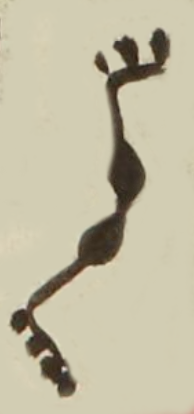Tepalnemi (MH736r)
This black-line drawing of the compound glyph for the personal name Tepalnemi (“Servant,” attested here as a man’s name) shows two footprints going in different directions. This -nemi may or may not have a phonetic indicator value. The term tepalnemi refers to a servant, not literally to someone who goes around with others. But a servant will sometimes live with others.
Stephanie Wood
Footprint glyphs have a wide range of translations. In this collection, so far, we can attest to yauh, xo, pano, pan, paina, temo, nemi,
quetza, otli, iyaquic hualiloti, huallauh, tepal, tetepotztoca, totoco,
otlatoca, -tihui, and the vowel "o." Other research (Herrera et al, 2005, 64) points to additional terms, including: choloa, tlaloa, totoyoa, eco, aci,
quiza, maxalihui, centlacxitl, and xocpalli.
Stephanie Wood
1560
Jeff Haskett-Wood
footprints, huellas, steps, pasos, icximachiyotl, xocpalli, icxipamitl, stones, piedras, sirvientes, mozos, servants, live-in, nombres de hombres

tepalnemi, servant, https://nahuatl.wired-humanities.org/content/tepalnemi
tepal nemi, one who lives with someone else, https://nahuatl.wired-humanities.org/content/tepal-nemi
tepal, in relation to another person, https://nahuatl.wired-humanities.org/content/tepal
nemi, to live, to go about, https://nahuatl.wired-humanities.org/content/nemi
Mozo de Servicio
Stephanie Wood
Matrícula de Huexotzinco, folio 736r, World Digital Library, https://www.loc.gov/resource/gdcwdl.wdl_15282/?sp=550&st=image
This manuscript is hosted by the Library of Congress and the World Digital Library; used here with the Creative Commons, “Attribution-NonCommercial-ShareAlike 3.0 License” (CC-BY-NC-SAq 3.0).



